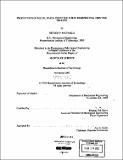Production of metal parts using the three dimensional printing process
Author(s)
Michaels, Steven P. (Steven Patrick)
DownloadFull printable version (6.818Mb)
Other Contributors
Massachusetts Institute of Technology. Dept. of Mechanical Engineering.
Advisor
Emanuel M. Sachs.
Terms of use
Metadata
Show full item recordAbstract
Three Dimensional Printing is a process for the rapid fabrication of three dimensional parts directly from computer models. A solid object is created by printing a sequence of two dimensional layers. The creation of each layer involves the spreading of a thin layer of powdered material followed by the selective joining of powder in the layer by ink-jet printing of a binder material. Commands to modulate the binder stream are derived from CAD data. Unbound powder temporarily supports unconnected portions of the component, allowing overhangs, undercuts and internal volumes to be created. The unbound powder is removed upon process completion, leaving the finished part. The Three Dimensional Printing process was initially developed to create alumina/silica molds for metal casting. A new process was developed to allow the 3DP system to directly fabricate metal parts. Stainless steel powder was layered in the powder bed and selectively joined by a latex polymer binder. Upon process completion, the powder bed was fired in an oven to cure the polymer in the printed regions. The resulting green part, a metal powder/polymer composite, could then be removed from the powder bed. The green part had properties similar to parts produced by the Metal Injection Molding process used in industry. Two sizes of spherical stainless steel powder, 20 and 75[mu]m, were used to print parts. These powders produced parts with green densities approaching 60%. Two types of water-based, thermosetting acrylic polymers, one an emulsion and the other a sol, were used as binders. These binder materials were compatible with the existing printhead and produced parts with satisfactory green strength. Using techniques borrowed from the fields of Powder Metallurgy and Metal Injection Molding, post-processing methods to debind, sinter and infiltrate the green printed parts were developed. An infiltrated 3D Printed part was used as a tooling insert to injection mold several polypropylene parts. Many new printing phenomena, previously unseen during the printing of alumina/silica parts, were observed during the creation of a printing process for metal parts. A process development strategy was devised which allowed these new printing problems to be systematically solved. The 3D Printing process was analyzed by dividing it into discrete steps and then modifying each of these steps to allow printing of metal parts. This process development strategy is generic and can be used to adapt the 3D Printing process to other materials systems in the future.
Description
Thesis (M.S.)--Massachusetts Institute of Technology, Dept. of Mechanical Engineering, February 1994. Includes bibliographical references (leaf 81).
Date issued
1994Department
Massachusetts Institute of Technology. Department of Mechanical EngineeringPublisher
Massachusetts Institute of Technology
Keywords
Mechanical Engineering.